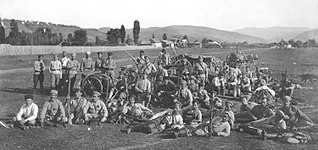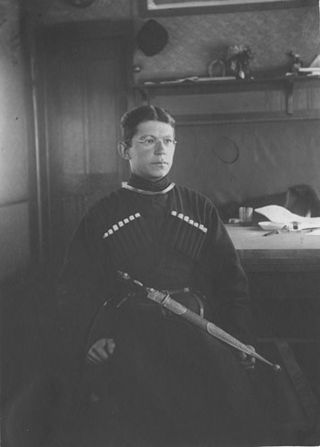
The White movement, also known as the Whites, was one of the main factions of the Russian Civil War of 1917–1922. It was led mainly by the right-leaning and conservative officers of the Russian Empire, while the Bolsheviks who led the October Revolution in Russia, also known as the Reds, and their supporters, were regarded as the main enemies of the Whites. It operated as a loose system of governments and administrations and military formations collectively referred to as the White Army, or the White Guard.

Andrei Grigoriyevich Shkuro was a Russian military officer of Cossack origin. He was a lieutenant general (1919) of the White Army, and later a Nazi collaborator.

Pyotr Nikolayevich Krasnov, also known as Peter Krasnov, was a Russian military leader, writer and later Nazi collaborator.

Viktor Leonidovich Pokrovsky was a Russian lieutenant general and one of the leaders of anti-communist counterrevolutionary White Army during the Russian Civil War.

The Sochi conflict was a three-party armed conflict which involved the counterrevolutionary White Russian forces, Bolshevik Red Army and the Democratic Republic of Georgia, each of which sought control over the strategic Black Sea town of Sochi. The conflict was fought as a part of the Russian Civil War and lasted with varying success from June 1918 to May 1919, and ended through British mediation.

The Southern Front was a military theater of the Russian Civil War.

The Don Army was the military of the short lived Don Republic and a part of the White movement in the Russian Civil War. It operated from 1918 to 1920, in the Don region and centered in the town of Novocherkassk.

The Ice March, also called the First Kuban Campaign, a military withdrawal lasting from February to May 1918, was one of the defining moments in the Russian Civil War of 1917 to 1921. Under attack by the Red Army advancing from the north, the forces of the Volunteer Army, sometimes referred to as the White Guard, began a retreat from the city of Rostov south towards the Kuban, in the hope of gaining the support of the Don Cossacks against the Bolshevik government in Moscow.

Alexei Ivanovich Avtonomov was a Russian Red Army military commander during the Russian Civil War.

The Volunteer Army, abbreviated to Добрармия, Dobrarmiya was a White Army active in South Russia during the Russian Civil War from 1917 to 1920. The Volunteer Army fought against Bolsheviks and the Makhnovists on the Southern Front and the Ukrainian War of Independence. On 8 January 1919, it was made part of the Armed Forces of South Russia, becoming the largest force of the White movement until it was merged with the Army of Wrangel in March 1920.

Afrikan Petrovich Bogaewsky or Bogayevsky was a Russian military leader from the Don Cossack noble family of Bogaewsky. He served as a lieutenant general in the Imperial Russian Army and also served as the ataman of the Don Republic.

Ivan Lukich Sorokin Russian: Ива́н Луки́ч Соро́кин; 4 December 1884 – 3 November 1918) was a Russian military leader and participant in the Russo-Japanese War, World War I, and the Russian Civil War. He was Commander-in-Chief of the Red Army of the North Caucasus and Commander of the 11th Red Army.

The Armed Forces of South Russia (AFSR or SRAF) (Russian: Вооружённые силы Юга России, romanized: Vooruzhyonniye sily Yuga Rossii, VSYuR) were the unified military forces of the White movement in southern Russia between 1919 and 1920.

The Battle of Tsaritsyn was a military confrontation between the Red Army and the White Army during the Russian Civil War for control of Tsaritsyn, a significant city and port on the Volga River in southwestern Russia.

The Iași–Don March, also known in Russia as Drozdovsky's March or the Romanian March, was a march of a Russian Volunteer detachment, led by Staff Colonel Mikhail Drozdovsky during the Russian Civil War. The detachment marched from Iași on the Romanian front to the Don, to join the White Russian Volunteer Army of General Lavr Kornilov and fight the Bolshevik enemy together. It took place between February 26 and April 24, 1918. This March, as well as the First Kuban Campaign, was a milestone in the formation of the White movement in Southern Russia.
The North Caucasus Operation was a strategic offensive conducted by the Caucasian Front of the Red Army against the White Armed Forces of South Russia in the North Caucasus region between 17 January and 7 April 1920. It took place on the Southern Front of the Russian Civil War and was a Soviet attempt to destroy White resistance.

The Northern Caucasus Operation was fought between the White and Red Armies during the Russian Civil War between December 1918 and March 1919. The White Army captured the entire Northern Caucasus. The Red Army withdrew to Astrahan and the Volga delta.
The Taman Army was an armed group within the Red Army, operating in the south of Russia during the Russian Civil War. It existed from August 27, 1918 to February 1919. The name derives from the Taman Peninsula, where the army was formed.

The battle for Donbas was a military campaign of the Russian Civil War that lasted from January to May 1919, in which White forces repulsed attacks of the Red Army on the Don Host Oblast and occupied the Donbas region after heavy fighting.

The Advance on Moscow was a military campaign of the White Armed Forces of South Russia (AFSR), launched against the RSFSR in July 1919 during the Russian Civil War. The goal of the campaign was the capture of Moscow, which, according to the chief of the White Army Anton Denikin, would play a decisive role in the outcome of the Civil War and bring the Whites closer to the final victory. After initial successes, in which the city of Oryol at only 360 kilometres (220 mi) from Moscow was taken, Denikin's overextended Army was decisively defeated in a series of battles in October and November 1919.


















